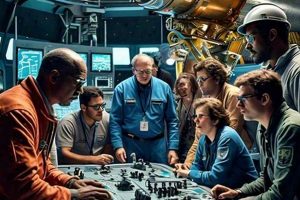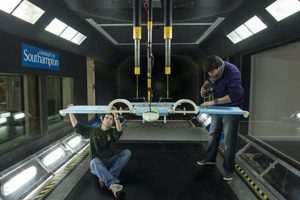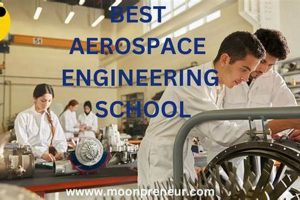The simultaneous pursuit of two engineering disciplines, specifically focusing on mechanical and aerospace principles, provides a breadth of knowledge spanning the design, analysis, and manufacturing of systems ranging from terrestrial machines to spacecraft. This multidisciplinary approach integrates core mechanical engineering concepts, such as thermodynamics, fluid mechanics, and materials science, with specialized aerospace topics like aerodynamics, propulsion, and orbital mechanics. A student undertaking this intensive course of study develops expertise applicable to a wide spectrum of engineering challenges.
The advantage of acquiring proficiency in both mechanical and aerospace domains lies in the enhanced adaptability and expanded career opportunities available to graduates. This comprehensive training cultivates a deeper understanding of complex systems and their interactions, fostering innovation and problem-solving capabilities. Historically, professionals with integrated skill sets have been instrumental in driving advancements in various industries, including automotive, energy, and defense, in addition to the core aerospace sector.
The following sections will delve into the curriculum demands, skill development, career prospects, and other relevant considerations for individuals contemplating this challenging yet rewarding academic path, providing a detailed exploration of the advantages and potential challenges associated with this interdisciplinary engineering education.
The rigorous nature of concurrently studying both mechanical and aerospace engineering demands meticulous planning and dedicated execution. To succeed in this challenging academic endeavor, consider the following guidelines:
Tip 1: Optimize Course Sequencing: Prioritize foundational courses in mathematics, physics, and basic engineering principles. Establishing a solid understanding of these core subjects will facilitate comprehension of more advanced topics in both disciplines. For example, complete calculus and differential equations before attempting thermodynamics or fluid mechanics.
Tip 2: Leverage Synergies Between Disciplines: Identify areas where mechanical and aerospace engineering principles overlap and reinforce each other. For instance, understanding heat transfer concepts is crucial for both internal combustion engine design (mechanical) and spacecraft thermal management (aerospace). Actively seeking these connections will enhance learning efficiency.
Tip 3: Cultivate Strong Time Management Skills: The workload associated with a combined engineering degree is substantial. Employ effective time management techniques, such as creating detailed schedules, setting realistic goals, and avoiding procrastination. Regular review and adjustment of the schedule are essential.
Tip 4: Seek Faculty and Peer Support: Engage with professors and teaching assistants during office hours to clarify difficult concepts. Collaborate with classmates on projects and assignments to foster a deeper understanding of the material. Form study groups that focus on specific topics or problem-solving techniques.
Tip 5: Prioritize Hands-On Experience: Participate in extracurricular activities, such as engineering clubs, design competitions, and research projects, to gain practical experience. Seek internships or co-op opportunities in relevant industries to apply theoretical knowledge to real-world challenges. Practical application reinforces classroom learning and enhances career prospects.
Tip 6: Maintain Physical and Mental Well-being: The demands of a combined engineering program can be stressful. Prioritize physical health through regular exercise and a balanced diet. Practice stress-reduction techniques, such as meditation or mindfulness, to maintain mental well-being. Adequate sleep is also crucial for cognitive function and academic performance.
Adherence to these principles can significantly enhance the likelihood of success in this demanding yet rewarding academic pursuit, equipping graduates with a powerful skill set and a broad range of career opportunities.
The subsequent sections will explore specific career paths, required skills, and industry trends relevant to those holding degrees in these combined engineering fields.
1. Curriculum Rigor
The curriculum associated with concurrently pursuing mechanical and aerospace engineering is inherently rigorous. This stems from the comprehensive knowledge base and advanced skill set required to master both disciplines. The demands on students are significant, necessitating a structured and disciplined approach to learning.
- Extensive Course Load
The combined curriculum involves a substantial number of credit hours, often exceeding the requirements for a single engineering major. Students must complete core courses in both mechanical and aerospace engineering, covering subjects such as thermodynamics, fluid mechanics, aerodynamics, structural analysis, and control systems. The sheer volume of material demands exceptional time management and study skills.
- Advanced Mathematical Foundations
Both mechanical and aerospace engineering rely heavily on advanced mathematical concepts, including differential equations, linear algebra, and numerical methods. Students must develop a strong understanding of these mathematical tools to effectively analyze and solve complex engineering problems. For example, finite element analysis, a crucial technique for structural design, requires a solid foundation in linear algebra and calculus.
- Project-Based Learning
Engineering curricula often incorporate project-based learning, where students apply theoretical knowledge to real-world design challenges. In a combined program, these projects may require integrating principles from both mechanical and aerospace engineering. For instance, students might design a robotic system for space exploration, requiring expertise in mechanical design, control systems, and aerospace propulsion.
- Laboratory Experience
Hands-on laboratory experience is an essential component of engineering education. Students gain practical skills in experimentation, data analysis, and report writing. A combined program necessitates laboratory work in both mechanical and aerospace engineering, exposing students to a wide range of equipment and techniques. Examples include wind tunnel testing, materials testing, and control system simulation.
The rigor inherent in this dual engineering curriculum prepares graduates to tackle complex and multifaceted engineering challenges across diverse industries. The combination of theoretical knowledge, advanced mathematical skills, project-based learning, and laboratory experience equips them with a comprehensive toolkit for innovation and problem-solving.
2. Interdisciplinary Skillset
The defining characteristic of pursuing concurrent degrees in mechanical and aerospace engineering lies in the development of a potent interdisciplinary skill set. This attribute is not merely a byproduct but a central and intended outcome of the rigorous curriculum. The coupling of these disciplines cultivates a graduate capable of synthesizing knowledge from traditionally distinct engineering domains, resulting in enhanced problem-solving abilities and a broader perspective on complex engineering challenges. For example, the design of a modern aircraft wing necessitates a deep understanding of both aerodynamic principles (aerospace engineering) and structural mechanics (mechanical engineering). Professionals possessing this interdisciplinary perspective are better equipped to optimize designs for both performance and structural integrity.
The demand for an interdisciplinary skill set extends beyond the aerospace industry. Consider the burgeoning field of robotics. The design and control of robotic systems often require the integration of mechanical components, such as actuators and sensors, with sophisticated control algorithms derived from aerospace engineering principles. Similarly, the development of advanced energy systems, such as wind turbines, benefits from the combined knowledge of fluid mechanics, structural analysis, and control systems. The ability to bridge these disparate fields is a direct result of the comprehensive training provided by studying both mechanical and aerospace engineering concurrently.
In summary, the pursuit of combined degrees in these engineering fields inherently fosters an interdisciplinary skill set, which is critical for addressing modern engineering challenges. Graduates emerge with the capacity to synthesize knowledge from diverse domains, facilitating innovative solutions and adaptable problem-solving approaches across a wide spectrum of industries. This interdisciplinary expertise offers a significant advantage in an increasingly complex and interconnected technological landscape, though it requires greater dedication and workload to attain.
3. Expanded Career Options
The simultaneous acquisition of knowledge and skills in both mechanical and aerospace engineering directly correlates with a broadened spectrum of potential career paths. This synergistic education equips graduates with a versatile skill set that is highly valued across numerous industries. Instead of being limited to roles within a single engineering domain, these individuals possess the adaptability to pursue opportunities in aerospace, automotive, manufacturing, energy, robotics, and other sectors that demand expertise in both mechanical systems and aerospace principles. The effect of this combined knowledge is a significantly increased likelihood of securing employment and greater flexibility in career trajectory.
The importance of expanded career options as a component of a double major in mechanical and aerospace engineering cannot be overstated. This broadened scope provides a buffer against industry-specific downturns and allows graduates to pivot their careers based on evolving market demands and personal interests. For example, an engineer trained in both fields could seamlessly transition from designing aircraft components to developing advanced automotive technologies or working on renewable energy systems. Consider the case of an aerospace engineer with mechanical expertise being instrumental in optimizing the design of wind turbine blades, leveraging their knowledge of aerodynamics and structural mechanics to enhance energy generation efficiency. This adaptability is a tangible advantage in a dynamic professional landscape.
In conclusion, the expanded career options afforded by a double major in mechanical and aerospace engineering represent a significant practical benefit. Graduates are not only prepared for traditional engineering roles but also possess the interdisciplinary skills to navigate and contribute to a wide range of industries. While the curriculum demands are substantial, the resulting versatility and enhanced employability make this academic path a strategic investment for aspiring engineers seeking a competitive edge and long-term career success. The ability to integrate principles from both domains facilitates innovation and problem-solving across diverse applications, solidifying the value of this combined engineering education.
4. Innovation Catalyst
The simultaneous study of mechanical and aerospace engineering acts as a catalyst for innovation by providing graduates with a unique combination of skills and knowledge that facilitates creative problem-solving and the development of novel technologies. This interdisciplinary foundation equips individuals to approach engineering challenges from multiple perspectives, fostering ingenuity and ingenuity.
- Cross-Pollination of Ideas
The integration of mechanical and aerospace engineering principles encourages the cross-pollination of ideas, leading to innovative solutions. Mechanical engineering focuses on the design and manufacturing of mechanical systems, while aerospace engineering deals with the design and operation of aircraft and spacecraft. Combining these fields allows engineers to apply concepts from one domain to the other, resulting in novel approaches to engineering challenges. For example, techniques used in aerospace structural design can be adapted to improve the performance of mechanical systems, and vice versa. This synergistic effect fuels innovation.
- Systems-Level Thinking
A combined education fosters systems-level thinking, enabling engineers to consider the interconnectedness of different components and subsystems. Innovation often arises from optimizing the interactions between various elements of a complex system. Mechanical engineers gain expertise in designing and analyzing individual components, while aerospace engineers develop a broader understanding of how these components integrate into larger systems. This holistic perspective facilitates the development of more efficient, reliable, and sustainable technologies. As an example, consider the design of an electric aircraft. It requires optimizing the electric motor (mechanical engineering) alongside the aerodynamic performance of the aircraft (aerospace engineering) to achieve efficient and safe operation.
- Adaptability and Problem-Solving
The rigorous curriculum associated with pursuing concurrent degrees in mechanical and aerospace engineering cultivates adaptability and strong problem-solving skills. Engineers trained in both disciplines are better equipped to handle unexpected challenges and adapt to changing technological landscapes. The ability to draw upon a broader knowledge base enables them to develop creative solutions to complex problems that require expertise in both mechanical and aerospace systems. This agility is crucial for driving innovation in rapidly evolving industries.
- Bridging Theoretical and Practical Knowledge
This educational path facilitates the effective bridging of theoretical knowledge with practical application. By engaging in hands-on projects and research opportunities that span both mechanical and aerospace disciplines, students learn to translate abstract concepts into tangible solutions. This practical experience reinforces theoretical understanding and encourages the development of innovative designs and processes. For instance, a student might design and build a small-scale wind tunnel to test aerodynamic principles, combining theoretical knowledge of fluid mechanics with practical skills in fabrication and instrumentation.
In summary, the dual expertise gained from studying both mechanical and aerospace engineering provides a fertile ground for innovation. The interdisciplinary perspective, systems-level thinking, adaptability, and practical experience equip graduates to drive technological advancements across diverse industries. By fostering a culture of creativity and problem-solving, this combined education contributes significantly to the development of cutting-edge technologies and innovative solutions to complex engineering challenges.
5. Systems Integration Expertise
Systems integration expertise, a critical skill in modern engineering, is significantly enhanced by a dual degree in mechanical and aerospace engineering. The complexity of contemporary engineering projects demands professionals capable of understanding and integrating diverse systems, and this combination of disciplines uniquely prepares graduates for such roles.
- Holistic Design Perspective
Graduates with combined mechanical and aerospace engineering backgrounds possess a holistic design perspective. This stems from their exposure to both the detailed aspects of mechanical components and the broader considerations of aerospace systems. For example, in the design of an unmanned aerial vehicle (UAV), the mechanical engineer focuses on the propulsion system and structural integrity, while the aerospace engineer concentrates on aerodynamics and control systems. Integrating these perspectives results in a more efficient and robust UAV design.
- Interdisciplinary Communication
Effective communication across engineering disciplines is vital for successful systems integration. A dual degree in mechanical and aerospace engineering fosters this communication by providing a common understanding of the terminology, principles, and challenges associated with both fields. This shared knowledge base facilitates seamless collaboration between engineers specializing in different areas, enabling them to work together more effectively on complex projects such as the development of a new spacecraft or advanced transportation systems.
- Problem-Solving Capabilities
Systems integration often involves troubleshooting complex problems that arise from the interactions between different systems. The combined education equips individuals with enhanced problem-solving capabilities by providing them with a wider range of analytical tools and techniques. They can draw upon their knowledge of mechanical systems, aerodynamics, control systems, and materials science to diagnose and resolve issues that would be difficult for engineers trained in a single discipline to address. This leads to faster and more effective solutions to integration challenges.
- Optimization Across Systems
Achieving optimal performance requires careful consideration of how different systems interact and influence each other. A dual degree in mechanical and aerospace engineering provides graduates with the skills to optimize performance across multiple systems simultaneously. For example, in the development of a fuel-efficient aircraft, engineers must balance the aerodynamic performance of the wings with the weight and efficiency of the propulsion system. Graduates with expertise in both mechanical and aerospace engineering are uniquely qualified to optimize these interdependent systems, leading to significant improvements in overall performance.
These facets of systems integration expertise, cultivated through the rigorous curriculum of a double major in mechanical and aerospace engineering, demonstrate the program’s value in preparing engineers for the increasingly complex and interdisciplinary challenges of modern engineering projects. The ability to understand, communicate, and problem-solve across diverse engineering systems is a critical asset for professionals seeking to innovate and lead in a technologically advanced world.
Frequently Asked Questions
This section addresses common inquiries and misconceptions regarding the pursuit of concurrent degrees in mechanical and aerospace engineering, providing clarity for prospective students.
Question 1: Is a double major in mechanical and aerospace engineering excessively demanding?
The curriculum is rigorous, requiring a significant commitment of time and effort. However, with effective time management, strategic course selection, and dedicated study habits, successful completion is attainable. Prospective students should carefully consider their academic aptitude and work ethic before embarking on this demanding academic path.
Question 2: What are the primary advantages of obtaining degrees in both mechanical and aerospace engineering?
The principal benefits include an enhanced interdisciplinary skill set, expanded career opportunities across diverse industries, increased problem-solving capabilities, and a greater capacity for innovation. Graduates are well-prepared for roles requiring expertise in both mechanical systems and aerospace principles.
Question 3: How does the curriculum differ from pursuing a single major in either mechanical or aerospace engineering?
The double major curriculum necessitates a broader range of courses, encompassing core subjects from both disciplines. While there may be some overlap, students are required to delve into specialized topics in each field, resulting in a more comprehensive understanding of engineering principles. This typically translates to more credit hours and a heavier workload.
Question 4: Are there specific career paths better suited for graduates with this combined expertise?
Several career paths benefit significantly from this interdisciplinary training. These include roles in the aerospace industry involving the design and development of aircraft and spacecraft, positions in the automotive industry focused on advanced vehicle technologies, opportunities in robotics requiring expertise in both mechanical systems and control algorithms, and roles in the energy sector focused on renewable energy systems.
Question 5: What are the key skills that students should develop to succeed in this academic program?
Essential skills include strong mathematical proficiency, excellent problem-solving abilities, effective time management techniques, the capacity for independent learning, and the ability to collaborate effectively with peers. A proactive approach to seeking assistance from faculty and leveraging available resources is also crucial.
Question 6: Does this combination of degrees provide a significant advantage in the job market?
A double major in mechanical and aerospace engineering can provide a distinct competitive advantage in the job market. The expanded skill set and broadened knowledge base make graduates highly attractive to employers seeking versatile and adaptable engineers capable of tackling complex challenges across multiple disciplines. However, demonstrated proficiency and relevant experience remain crucial factors in securing employment.
In summary, the pursuit of concurrent degrees in mechanical and aerospace engineering is a challenging but potentially rewarding academic path. Success requires a strong commitment to academic excellence, effective time management, and a proactive approach to learning.
The following section will explore case studies of successful professionals who have leveraged this combined expertise to achieve significant accomplishments in their respective fields.
Conclusion
This exploration has detailed the inherent characteristics of a double major mechanical and aerospace engineering, emphasizing the curricular demands, the cultivated interdisciplinary skill set, the broadened career prospects, the role as an innovation catalyst, and the systems integration expertise that such a course of study imparts. This rigorous academic path prepares graduates to address multifaceted engineering challenges across a spectrum of industries.
The decision to pursue this demanding combined degree requires careful consideration of individual aptitude and career aspirations. Success hinges on diligent application and a commitment to lifelong learning. The potential rewards, however, are substantial, positioning graduates as leaders and innovators in an increasingly complex technological landscape. Further research and thoughtful planning are strongly advised for those contemplating this academic endeavor.







